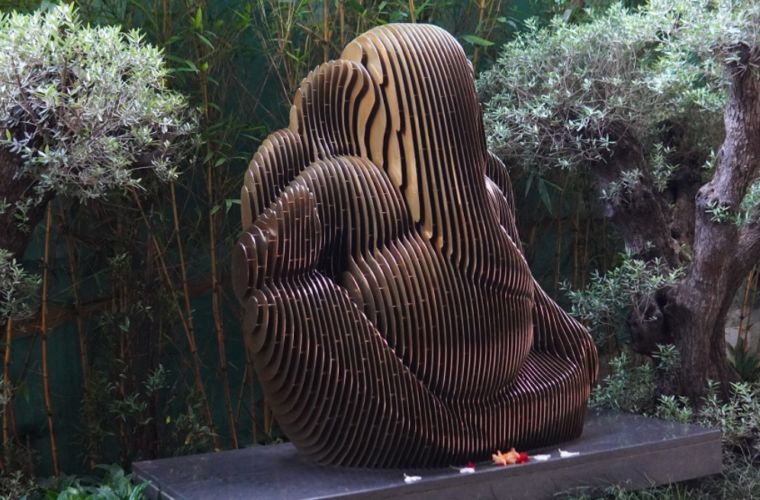Double-fold origami structure for Chennai temple
New Delhi-based and Rat[LAB] Studio and Chennai-based Shilpa Architects has designed The Scared Hendecagon Shirdi Sai Baba Temple in Chennai, which was to design a temple as the epicenter of a 338-acre masterplan project.
The architects were mandated to use the master number 11 as an element, symbolizing balance, vision, purity, masculinity and femininity, based on the client’s belief in Vaastu and numerology. The firm then developed a concept with an 11-sided polygon – a hendecagon – articulated as a three-dimensional polyhedron. Using mathematics, sacred geometry and structural logic, the polygon was designed keeping in mind environmental aspects such as radiation, daylight, shadow range and double-fold origami.
The masterplan, developed by Shilpa Architects, is inspired by the gode neem tree of Shirdi exploring mathematical progressions – resulting in a Agamashastre-based plan for the design foundation. The garbhagriha design is form-driven, while adhering to numerology and Vaastu, powered by computational design. Surrounded by a series of promenades, podium and landscaping, the temple is located 66 m. above the ground. Green stripes and shops on both sides break the monotony of the 525 ft. long promenade, which also frames the temple and guides the worshippers to the 154 ft. tall temple.
The temple comprises four zones: the front promenade, temple complex, rear promenade and the sanctum sanctorum – built under the principles of the Vaastu Purusha mandala. The front promenade marks the entrance by inviting visitors into the temple complex, spatially divided into counters for storage and shoes, a frisking area and an ablution area.
The meditation area is based on the 11-point circle pattern reiterated through the gathering spaces and roof of the garbhagriha. The flooring is designed to attract focus to the far end of the room rather than beneath the oculus of the polygonal roof in the center. Dividing the outer circumference into 11 equal segments, the position of the deity within the garbhagriha is fixed. The arcs radiating from this position connect to the segment points on the circumference, forming a petal-like pattern also translated to the oculus on the rooftop. Thus, the design creates an off-center focal point and maintains the sanctity of the master number.
Worshippers reach the podium through the maha-mandapa from the general or VIP queuing system, permitting them to visit the three shrines in front of the garbhagriha, meditation pockets or gathering spaces. The flooring pattern in the main hall follows a mathematical looping system using 11 vertices to the hendecagon. A recursive division of that creates an asymmetry towards the deity, and a focal point at the ground level to guide devotees for prayer and offerings. The double-fold origami structure creates a rigid structure with fluid columns blending into the interiors, while rendering a shell-like structure.


![SaiBabaTemple_rat[LAB] (01)](https://ifj.co.in/wp-content/uploads/2021/06/SaiBabaTemple_ratLAB-01.jpg)
![SaiBabaTemple_rat[LAB] (07)](https://ifj.co.in/wp-content/uploads/2021/06/SaiBabaTemple_ratLAB-07.jpg)
![SaiBabaTemple_rat[LAB] (13)](https://ifj.co.in/wp-content/uploads/2021/06/SaiBabaTemple_ratLAB-13.jpg)
![SaiBabaTemple_rat[LAB] (15)](https://ifj.co.in/wp-content/uploads/2021/06/SaiBabaTemple_ratLAB-15.jpg)
![SaiBabaTemple_rat[LAB] (03)](https://ifj.co.in/wp-content/uploads/2021/06/SaiBabaTemple_ratLAB-03.jpg)
![SaiBabaTemple_rat[LAB] (04)](https://ifj.co.in/wp-content/uploads/2021/06/SaiBabaTemple_ratLAB-04.jpg)


